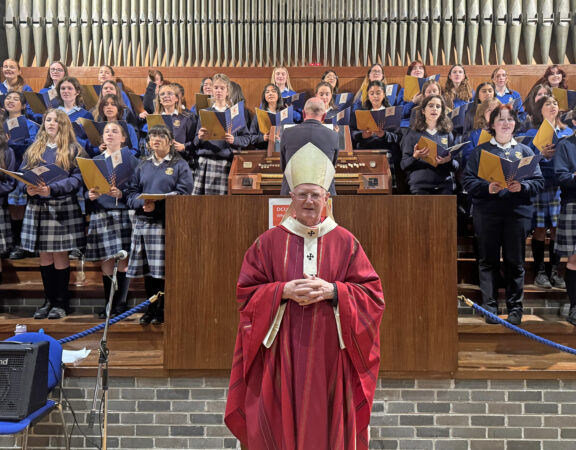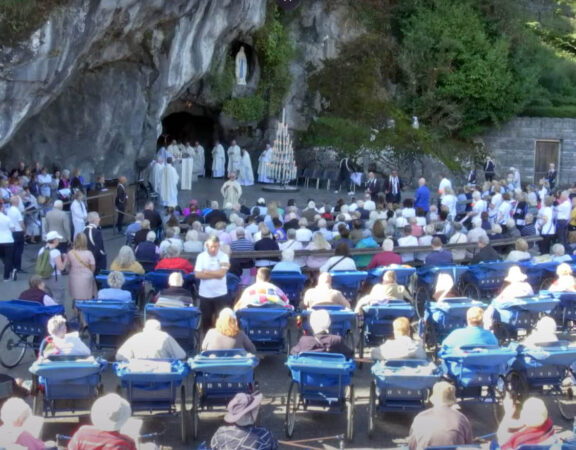Archbishop Martins address at opening of 1932 Congress Exhibition
Those who work with me know that there is one place in our diocesan system where they do not like me to visit and that is the archives. They know that if I go to the Archives that is it for the day. If I get interested in some aspect of the archives then I just keep asking to see more and arrive back much later in the day covered in that special dust which you only find in archives.
I am not a historian, but I am fascinated by the small aspects of history: the details of people and the details of how the lived and what they did in their lives. That is why I was really excited when I heard of the idea of holding this exhibition which looks back to the 1932 Eucharistic Congress. You can only appreciate any historical event in the context of the world in which it took place. To understand what the 1932 Congress signified, you have to look at its context, just as to prepare for the 2012 Congress you have to look at the socio-religious context of our times.
The challenge in preparing for this year’s 50th International Eucharistic Congress has been to make it a Congress for our times, without missing the important lessons which we can learn about the 1932 Congress and its significance for those times. It is very easy to make comments on the 1932 Congress in a context which ignores history. If you ignore the true history of the past you can end up with a prejudicial view of the realities of today.
The memory of the 31st International Eucharistic Congress held in Dublin in 1932 holds a special place in the hearts and minds of Irish people. I know that some of you here today were at the event in 1932 and I hope the exhibition brings back good memories of what was, up to that moment, the biggest public event ever held in Ireland.
The Irish Free State was only 10 years old and the Congress provided an opportunity to show the world that we thought of ourselves. The Eucharistic Congress was the first national event in which the two political sides who had taken part in a bitter Civil War came together to work on a common project. This was one of the great intuitions of my predecessor Archbishop Edward Byrne. Eucharist can forge reconciliation. Our communion with Christ radically affects the way our communion with one another is shaped.
My hope is that this upcoming Eucharistic Congress will be an occasion of reflecting the realities of the Church in Ireland today and of being a moment of renewal and healing. I extend an open invitation to all those in our communities who love the Church and yet may have different views about the Church to come to the Eucharistic Congress as a place where hearts can meet. The fellowship of those who love the Church is shaped in the Eucharist.
1932 was an interesting moment and 1932 was politically a significant year. The 1932 General Election had brought about a change of government. Papers in the Vatican Archives show that the then Cardinal Secretary of State, Pacelli, later Pope Pius XII, was anxious that the “Fianna Fail Rebels” might not be as interested in the Congress and the Church as “Mr Cosgrave’s government” had been. The new Chairman of the Free State Council, Eamon De Valera, on his part was practically on non-speaking terms with the Governor General. The Governor General on his part was anxious to assert his position and created a serious of protocol challenges.
As the Papal Legate and his team made the long journey from Rome by train and ship, spending their last night before their arrival in Dublin in Chester, they had to attempt to resolve problems posed urgently by the Governor General concerning the precise nature of the toast which would be proposed during dinner in his Phoenix Park residence for the visiting cardinals – at which no Irish Bishop was to be invited – as to whether it be to ”The King” or “The Pope” or “The King and the Pope” or “The Pope and the King”.
Such niceties of diplomatic practice were a long way from the situation of the ordinary catholic people of Ireland just three years after the Great Depression. The exhibition shows that they were concerned about more simple fare. It is noted that they consumed 30 tons of potatoes, 4,000 tins of fruit and vegetables, 1 ton of tea and 1.5 tons of sugar, thousands of bottles of soft drinks and tons of ice-cream were required. Each day 150 gallons of milk were needed. Medical situations note that over Congress Week there were 6 cases of sunstroke, 14 cases of poisoning and 102 cases of hysteria.
It is also important to recall that while the main Congress events took place in Dublin, the Cardinal Legate did manage to travel north as far as Armagh stopping at various towns along the way. He also went to the south-west to visit Killarney and in every town and village people had gone to great lengths to decorate the streets and be part of this incredible event. The images on display show a sample of these places and I am sure the people in the photos never thought they would end up in an exhibition 80 years later.
The means of transport were very different. No one arrived by air. The means of communication were very different to those of today. The opening of the RTE transmitter at Athlone was speeded up for the opening of the Congress and the 1932 event was the first one ever to use modern technology. The 15 miles of the processional route from the Phoenix Park to O’Connell Bridge were covered with 400 loudspeakers. This made it possible to synchronise the singing of hymns and the reciting of the rosary. In fact the system was so good that it seemed like a profanation for any man to wear his hat within their range when the service was going on at least that was according to a reporter from ‘The Tablet’ newspaper.
I can’t help but mention the incredibly rich vestments and the other ecclesiastical items that have been gathered for the exhibition, many of them coming from the Pro Cathedral and many being together for the first time since 1932. The vestments were made by the sisters of WB Yeats and were handmade. They are incredible works of art in their own right and their inclusion adds something every special to the exhibition.
As I formally launch the exhibition, I would just like to thank everyone involved in getting this exhibition together, all the donors and those who gifted items to the Archives, Gerard Whelan and all the staff in the RDS Library, Leo Duffy and his staff in Yellowstone, all the volunteers in the Diocesan Archives especially Peter Sobolewski, Suzanne Hynes and Patrick Lynch for many of the images used today.
May I say that it is particularly felicitous that the greatest part of the Congress will take place here in the RDS and I would like to especially thank the President and the entire community of the Royal Dublin Society for the extraordinary support that they have given to the Congress. Finally I express my sincere gratitude to the mind and heart behind the exhibition, Noelle Dowling.







